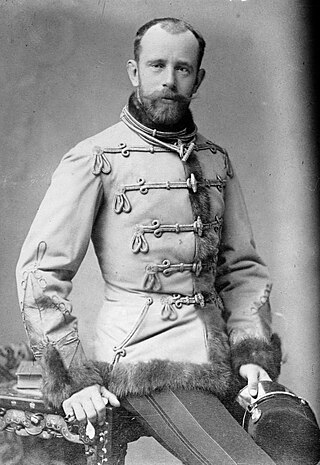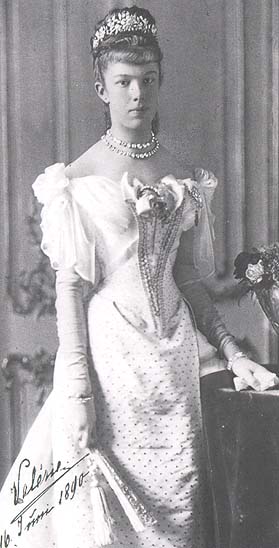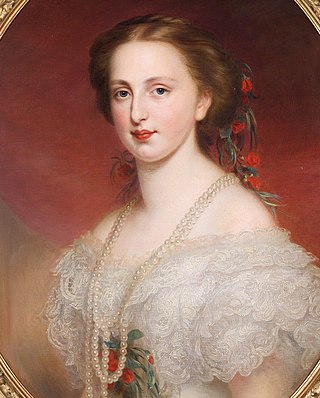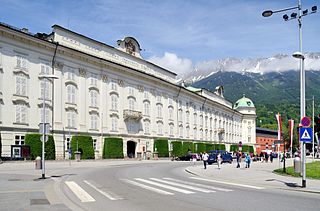
The Kaiservilla in Bad Ischl, Upper Austria, was the summer residence of Emperor Franz Joseph I and Empress Elisabeth of Austria, known as Sisi. [1] The mansion is currently the residence of their great-grandson Archduke Markus Emanuel Salvator.

The Kaiservilla in Bad Ischl, Upper Austria, was the summer residence of Emperor Franz Joseph I and Empress Elisabeth of Austria, known as Sisi. [1] The mansion is currently the residence of their great-grandson Archduke Markus Emanuel Salvator.
Originally the palace was a Biedermeier villa belonging to a Viennese notary named Josef August Eltz. In 1850 it was purchased by Eduard Mastalier. After Franz Joseph's engagement to Princess Elisabeth of Bavaria in 1853, Franz Joseph's mother, Princess Sophie of Bavaria, purchased the villa as a wedding present for the couple.
In subsequent years, the villa was altered and expanded in a Neoclassical style by Antonio Legrenzi. The extant central portion was expanded towards the park and the originally posterior portion of the house was converted to form the entrance with Classical columns and tympana. Two additional wings were constructed, giving the building the overall shape of an "E".
The villa is surrounded by a large park in the "English Style". The architectural ensemble in its contemporary form was completed in 1860. Construction was significantly slowed by the fact that it could not proceed during the summer months due to the presence of the royal family.
Today, the mansion is home to the Archduke Markus, but also offers grounds tours to the public. [2]

Elisabeth, nicknamed Sisi or Sissi, was Empress of Austria and Queen of Hungary from her marriage to Emperor Franz Joseph I on 24 April 1854 until her assassination in 1898.

Rudolf, Crown Prince of Austria was the only son and third child of Emperor Franz Joseph I of Austria and Duchess Elisabeth of Bavaria (Sisi). He was heir apparent to the imperial throne of the Austro-Hungarian Empire from birth. In 1889, he died in a suicide pact with his mistress Mary Vetsera at the Mayerling hunting lodge. The ensuing scandal made international headlines.
Elisabeth of Austria may refer to:

Archduchess Gisela Louise Marie of Austria was the second daughter and eldest surviving child of Emperor Franz Joseph I and Empress Elisabeth of Austria. She became a Princess of Bavaria through her marriage to her second cousin, Leopold.

Archduchess Sophie of Austria was the first child of Emperor Franz Joseph I and Empress Elisabeth of Austria. She died aged two.

Archduchess Marie Valerie Mathilde Amalie of Austria was the youngest child of Emperor Franz Joseph I and Empress Elisabeth of Austria. She was usually called Valerie.

Princess Sophie of Bavaria was the daughter of King Maximilian I Joseph of Bavaria and his second wife, Caroline of Baden. The identical twin sister of Queen Maria Anna of Saxony, Sophie became Archduchess of Austria by marriage to Archduke Franz Karl of Austria. Her eldest son, Franz Joseph, reigned as Emperor of Austria and King of Hungary; her second son, Maximilian, briefly reigned as Emperor of Mexico.

Sophie, Duchess of Hohenberg was the wife of Archduke Franz Ferdinand of Austria, the heir to the Austro-Hungarian throne. Their assassination in Sarajevo sparked a series of events that led, four weeks later, to World War I.

The Imperial Crypt, also called the Capuchin Crypt (Kapuzinergruft), is a burial chamber beneath the Capuchin Church and monastery in Vienna, Austria. It was founded in 1618 and dedicated in 1632, and located on the Neuer Markt square of the Innere Stadt, near the Hofburg Palace. Since 1633, the Imperial Crypt serves as the principal place of entombment for the members of the House of Habsburg. The bones of 145 Habsburg royalty, plus urns containing the hearts or cremated remains of four others, are here, including 12 emperors and 18 empresses. The visible 107 metal sarcophagi and five heart urns range in style from puritan plain to exuberant rococo. Some of the dozen resident Capuchin friars continue their customary role as the guardians and caretakers of the crypt, along with their other pastoral work in Vienna. The most recent entombment was in 2023.149

Bad Ischl is a spa town in Austria. It lies in the southern part of Upper Austria, at the river Traun in the centre of the Salzkammergut region. The town consists of the Katastralgemeinden Ahorn, Bad Ischl, Haiden, Jainzen, Kaltenbach, Lauffen, Lindau, Pfandl, Perneck, Reiterndorf and Rettenbach. It is connected to the village of Strobl by the river Ischl, which drains from the Wolfgangsee, and to the Traunsee, into which the stream empties. It is home to the Kaiservilla, summer residence of Austro-Hungarian monarchs Emperor Franz Joseph I and Empress Elisabeth. In 2024, Bad Ischl will be one of the European Capitals of Culture – the third city in Austria after Graz (2003) and Linz (2009).

Princess Caroline Augusta of Bavaria was Empress of Austria by marriage to Francis I of Austria. She was the penultimate child and third daughter of King Maximilian I Joseph of Bavaria and Princess Augusta Wilhelmine of Hesse-Darmstadt. She firstly married to Crown Prince William of Württemberg in 1808, but they divorced 1814.

Sissi is a 1955 Austrian historical romance film written and directed by Ernst Marischka and starring Romy Schneider, Karlheinz Böhm, Magda Schneider, Uta Franz, Gustav Knuth, Josef Meinrad, Vilma Degischer and Peter Weck. Sissi is the first installment in the trilogy of films about Empress Elisabeth of Austria, who was known to her family as "Sisi". It was followed by The Young Empress and Fateful Years of an Empress.

Sissi – Fateful Years of an Empress is a 1957 Austrian film directed by Ernst Marischka and starring Romy Schneider, Karlheinz Böhm, Magda Schneider, Gustav Knuth and Josef Meinrad, costumes by Gerdago. It was entered into the 1958 Cannes Film Festival.

Amalie Auguste of Bavaria was a Bavarian princess by birth and Queen of Saxony by marriage to King John of Saxony.

Infanta Maria Theresa of Portugal was a Princess of the House of Braganza. She became by marriage an Archduchess of Austria and also sister-in-law of Emperors Franz Joseph I of Austria and Maximilian I of Mexico, as well as step-grandmother of Emperor Charles I of Austria.

The Volksgarten is a public park in the Innere Stadt first district of Vienna, Austria. The garden, which is part of the Hofburg Palace, was laid out by Ludwig Remy in 1821. The park was built over the city fortifications that were destroyed by Napoleon in 1809. The Volksgarten was opened to the public in 1823.

Princess Margaretha of Saxony, Duchess of Saxony was the eighth child and fifth eldest daughter of King John of Saxony and his wife Princess Amalie Auguste of Bavaria and a younger sister of Kings Albert of Saxony and George of Saxony. She was born in Dresden, then in the Kingdom of Saxony. Through her marriage to Archduke Charles Louis of Austria, Margaretha was a member of the House of Habsburg-Lorraine and an Archduchess and Princess of Austria and Princess of Hungary, Croatia, Bohemia, and Tuscany.

The Hofburg is a former Habsburg palace in Innsbruck, Austria, and considered one of the three most significant cultural buildings in the country, along with the Hofburg Palace and Schönbrunn Palace in Vienna. The Hofburg is the main building of a large residential complex once used by the Habsburgs that still includes the Noblewomen's Collegiate Foundation, the Silver Chapel, the Hofkirche containing Emperor Maximilian's cenotaph and the Schwarzen Mandern, the Theological University, the Tyrolean Folk Art Museum, Innsbruck Cathedral, the Congress, and the Hofgarten.

Princess Maximiliana Josepha Caroline of Bavaria, was a Princess of Bavaria, daughter of King Maximilian I Joseph of Bavaria and Queen Caroline of Baden.

The Empress is a 2022 German historical drama series based on the life of Empress Elisabeth of Austria, starring Devrim Lingnau in the title role, and Philip Froissant as Emperor Franz Joseph. It was released on Netflix on 29 September 2022. It was Netflix's second-most watched series worldwide for two weeks and the seventh most popular non-English series of 2022, with over 150 million hours streamed. On 8 November 2022, Netflix renewed it for a second season. Netflix also commissioned a companion novel, The Empress: A Novel, by Gigi Griffis, which was published two days before the series premiered on the streaming service.